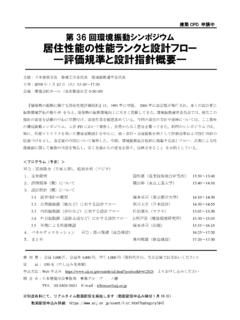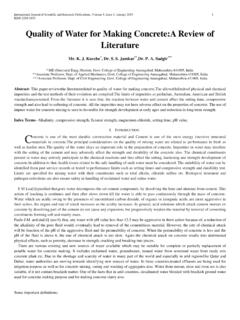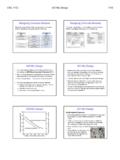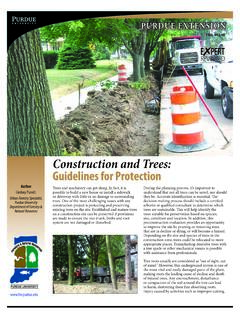Transcription of DESIGN RECOMMENDATION FOR STORAGE TANKS AND …
1 DESIGN RECOMMENDATION FOR STORAGE TANKS AND THEIR SUPPORTS WITH EMPHASIS ON SEISMIC DESIGN (2010 EDITION) ARCHITECTURAL INSTITUTE OF JAPAN i Foreword The Architectural Institute of Japan set up a Sub-Committee for DESIGN of STORAGE TANKS to provide a RECOMMENDATION of the seismic DESIGN for the various types of STORAGE TANKS in common use throughout Japan. The Sub-Committee first published DESIGN RECOMMENDATION for STORAGE TANKS and Their Supports in 1984, and amended it in the 1990, 1996 and 2010 publications. This current revised RECOMMENDATION provides bulk material pressures for silos and further guidance on seismic DESIGN methods for STORAGE TANKS based on the horizontal load-carrying capacity in the structure.
2 It is envisaged by publishing the English version of DESIGN RECOMMENDATION for STORAGE TANKS and Their Supports that the above unique DESIGN RECOMMENDATION will be promoted to the overseas countries who are concerned on the DESIGN of STORAGE TANKS and the activities of the Architectural Institute of Japan will be introduced them too. It is addressed how this RECOMMENDATION is in an advanced standard in terms of the theory of the restoring force characteristics of the structure considering the Elephant Foot Bulge (EFB), the effect of the uplifting tank and the plastic deformation of the bottom plate at the shell-to-bottom juncture in the event of earthquake, the DESIGN spectrum for sloshing in TANKS , the DESIGN pressure for silos, and the DESIGN methods for the under-ground STORAGE TANKS as well.
3 The body of the RECOMMENDATION was completely translated into English but the translation of the commentary was limited to the minimum necessary parts for understanding and utilising the theories and equations in the body. The sections Timbers and Wooden STORAGE TANKS are omitted as they are not common in overseas countries. Listing of some Japanese references are omitted and some new references are added in this English version. It is worthy of note that the contents of this RECOMMENDATION have been verified and their efficacy confirmed by reference to data obtained from the TANKS and silos damaged during recent earthquakes in Japan, including the Hanshin-Awaji Great Earthquake in 1995 and the Niigataken Chuetu-oki Earthquake in 2007.
4 Ii Introduction There are several types of STORAGE TANKS , , above-ground, flat-bottomed, cylindrical TANKS for the STORAGE of refrigerated liquefied gases, petroleum, etc., steel or concrete silos for the STORAGE of coke, coal, grains, etc., steel, aluminium, concrete or FRP TANKS including elevated TANKS for the STORAGE of water , spherical TANKS (pressure vessels) for the STORAGE of high pressure liquefied gases, and under-ground TANKS for the STORAGE of water and oil. The trend in recent years is for larger TANKS , and as such the seismic DESIGN for these larger STORAGE TANKS has become more important in terms of safety and the environmental impact on society as a whole.
5 The failure mode of the STORAGE tank subjected to a seismic force varies in each structural type, with the structural characteristic coefficient (Ds) being derived from the relationship between the failure mode and the seismic energy transferred to, and accumulated in the structure. A cylindrical steel tank is the most common form of STORAGE tank and its normal failure mode is a buckling of the cylindrical shell, either in the so called Elephant Foot Bulge (EFB), or as Diamond Pattern Buckling (DPB). The Ds value was originally calculated with reference to experimental data obtained from cylindrical shell buckling, but was later re-assessed and modified based on the restoring force characteristics of the structure after buckling.
6 Those phenomena at the Hanshin-Awaji Great Earthquake and the Niigataken Chuetu-oki Earthquake were the live data to let us review the Ds value. For the EFB, which is the typical buckling mode of a cylindrical shell STORAGE tank for petroleum, liquefied hydrocarbon gases, etc., it became possible to ascertain the buckling strength by experiments on a cylindrical shell by applying an internal hydrodynamic pressure, an axial compressive force, and a shear force simultaneously. Details of these experiments are given in Chapter 3. The seismic DESIGN calculations for other types of STORAGE TANKS have been similarly reviewed and amended to take into account data obtained from recent experience and experiments.
7 DESIGN RECOMMENDATION for sloshing phenomena in TANKS has been added in this publication. DESIGN spectra for sloshing, spectra for long period range in other words, damping ratios for the sloshing phenomena and pressures by the sloshing on the tank roof have been presented. For above-ground vertical cylindrical STORAGE TANKS without any restraining element, such as anchor bolts or straps, to prevent any overturning moment, only the bending resistance due to the uplift of the rim of bottom plate exists. This RECOMMENDATION shows how to evaluate the energy absorption value given by plasticity of the uplifted bottom plate for unanchored TANKS , as well as the Ds value of an anchored cylindrical steel-wall tank.
8 As the number of smaller under-ground TANKS used for the STORAGE of water and fuel is increasing in Japan, the Sub-committee has added them in the scope of the RECOMMENDATION and provided a framework for the seismic DESIGN of under-ground TANKS . The RECOMMENDATION has accordingly included a new response displacement method and a new earth pressure calculation method, taking into account the DESIGN methods adopted by the civil engineering fraternity. For silo DESIGN , additional local pressure which depends on eccentricity of discharge outlet, and equations which give approximate stress produced by this pressure are given in this 2010 publication.
9 August 2011 Sub-committee for DESIGN of STORAGE TANKS The Architectural Institute of Japan iii COMMITTEE FOR STRUCTURES (2010) Chairman Masayoshi NAKASHIMA Secretaries Hiroshi OHMORI Hiroshi KURAMOTO Kenji MIURA Members (Omitted) SUB COMMITTEE FOR DESIG OF STORAGE TA KS (2010) Chairman Yukio NAITO Secretaries Nobuyuki KOBAYASHI Hitoshi HIROSE Members Hiroshi AKIYAMA Yasushi UEMATSU Toshio OKOSHI Hitoshi KUWAMURA Minoru KOYAMA Kouichi SHIBATA Hideo NISHIGUCHI Katsu-ichiro HIJIKATA Hiroaki MORI Yutaka YAMANAKA Jun YOSHIDA WORKI G GROUP FOR SEISMIC LOAD A D RESPO SE ESTIMATIO OF STORAGE TA KS (2008) Chairman Yukio NAITO Secretary Nobuyuki KOBAYASHI Hitoshi HIROSE Members Tokio ISHIKAWA Shinsaku ZAMA Hitoshi SEYA Nobuo NAKAI Hideo NISHIGUCHI Katsu-ichiro HIJIKATA Tetsuya MATSUI iv Table of Contents 1 General ---------------------------------------- ---------------------------------------- - 1 Scope ---------------------------------------- ---------------------------------------- --- 1 Notations ---------------------------------------- --------------------------------------- 1 2 Materials ---------------------------------------- --------------------------------------- 3 Scope
10 ---------------------------------------- ---------------------------------------- --- 3 Steels ---------------------------------------- ---------------------------------------- --- 3 Stainless Steels ---------------------------------------- -------------------------------- 4 concrete ---------------------------------------- ---------------------------------------- 4 Aluminium Alloys ---------------------------------------- ---------------------------- 4 FRP ---------------------------------------- ---------------------------------------- ----- 5 Timber ---------------------------------------- ---------------------------------------- -- 6 3 DESIGN Loads ---------------------------------------- ---------------------------------- 9 General ---------------------------------------- ---------------------------------------- - 9 Dead Loads ---------------------------------------- ------------------------------------ 9 Live Loads ---------------------------------------- ------------------------------------- 9 Snow Loads ---------------------------------------- ------------------------------------ 9 Wind Loads ---------------------------------------- ---------------------------------- 10 Seismic Loads ---------------------------------------- ------------------------------- 10 DESIGN of Cylindrical Metal Shell Wall













